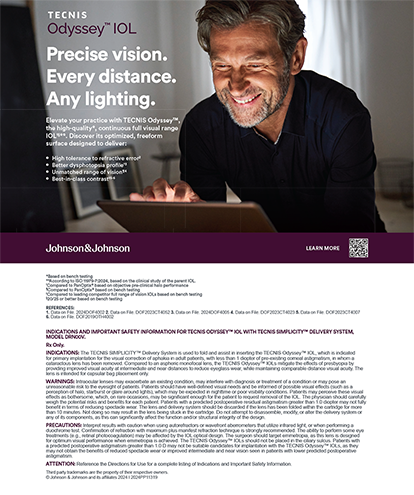European Multicenter Trial of the Prevention of Cystoid Macular Edema After Cataract Surgery in Nondiabetics: ESCRS PREMED Study Report 1
Wielders LHP, Schouten JSAG, Winkens B, et al; ESCRS PREMED Study Group1
ABSTRACT SUMMARY
Despite various advances in the techniques of cataract surgery, cystoid macular edema (CME) remains a postoperative complication of phacoemulsification that can affect the visual acuity of the operated eye.2-5 This randomized clinical trial compared the efficacy of a topical NSAID, a topical corticosteroid, and a combination of both regimens for the prevention of CME after phacoemulsification in nondiabetic patients at 6 and 12 weeks postoperatively.1 This study enrolled 914 nondiabetic patients who had undergone phacoemulsification cataract surgery. They were randomly assigned to receive topical bromfenac 0.09% twice daily for 2 weeks; topical dexamethasone 0.1% four times daily, decreased by one drop per day every subsequent week; or a combination of both regimens.
Central subfield mean macular thickness was 288.3, 296.0, and 284.5 µm, respectively, in the bromfenac, dexamethasone, and combination-treatment groups. The incidence of CME within 12 weeks after surgery in these groups, respectively, was 3.6%, 5.1%, and 1.5%.
The investigators reported that patients treated with a combination of a topical NSAID and corticosteroid had a lower risk of developing CME after cataract surgery than patients treated with either drug alone.
DISCUSSION
CME after cataract surgery, also known as Irvine-Gass syndrome, was reported by Irvine in 1953 and by Gass and Norton in 1969.6,7 Since then, several investigators have attempted to identify the optimal regimen for preventing this postoperative complication. Although researchers have investigated the use of topical corticosteroids and/or NSAIDs for CME prevention, there remains a lack of clinically significant data to develop an effective treatment regimen.
STUDY IN BRIEF
• A randomized clinical trial compared the efficacy of a topical NSAID (bromfenac 0.09%), a topical corticosteroid (dexamethasone 0.1%), or a combination of both for preventing cystoid macular edema (CME) after uneventful cataract surgery in nondiabetic patients. The results suggest that nondiabetic patients treated with a combination of an NSAID and a corticosteroid are at less risk of developing CME after cataract surgery than nondiabetic patients treated with either topical agent singly.
WHY IT MATTERS
Cataract extraction is the most common surgical procedure, with 4 million surgeries performed each year in the United States and almost 20 million per year worldwide. Minor improvements in perioperative management could thus drastically reduce the incidence of postoperative side effects such as CME on a global scale. Various precautionary treatments have been evaluated, but there is no proven standard treatment regimen to prevent CME after cataract surgery.
In this trial, the ESCRS PREMED Study Group demonstrated the efficacy of a combination of topical drops on the operated eye, the visual acuity outcomes of the patients, and the reduced incidence of CME.1 The central subfield mean macular thickness was lowest in patients treated with the combined regimen; this metric was 9.6 µm higher in the dexamethasone group and 2.7 µm higher in the bromfenac group compared to the combination group. Moreover, the incidence of CME was lowest in the combination group compared to either group of patients treated with one of the individual drugs. With its excellent design and large cohort, this study offered conclusive data that the best strategy for preventing CME after cataract surgery is to administer a combination of steroid and NSAID eye drops. Future studies should evaluate the cost-efficiency of administering these topical agents after cataract surgery. Other research should aim to develop an agent that combines the efficacy of a steroid and an NSAID in order to reduce the number of eye drops, frequency of administration, and overall cost of treatment.
Randomized Controlled European Multicenter Trial on the Prevention of Cystoid Macular Edema after Cataract Surgery in Diabetics: ESCRS PREMED Study Report 2
Wielders LHP, Schouten JSAG, Winkens B, et al; ESCRS PREMED Study Group8
ABSTRACT SUMMARY
In this randomized clinical trial, researchers compared the efficacy of pairing a combination of a topical NSAID and corticosteroid (bromfenac 0.09% and dexamethasone 0.1%) with four proposed additional treatments in diabetic patients for the prevention of CME after cataract surgery. All patients who had undergone phacoemulsification cataract surgery and combined topical treatment were randomly assigned to receive no additional treatment, a subconjunctival injection of 40 mg triamcinolone acetonide, an intravitreal injection of 1.25 mg bevacizumab, or a combination of both injected drugs. This study enrolled 213 diabetic patients. Individuals who had severe preoperative diabetic macular edema and proliferative or nonproliferative diabetic retinopathy were excluded.
After surgery, central subfield mean macular thickness was lower in patients who received 40 mg subconjunctival triamcinolone acetonide than those who did not receive a steroid injection. At 6 weeks, central subfield mean macular thickness was 12.3 µm lower in patients who received a subconjunctival corticosteroid injection than in those who did not. At 12 weeks, central subfield mean macular thickness was 9.7 µm lower in patients who received a subconjunctival corticosteroid injection than in those who did not. Additionally, mean total macular volume was 0.2 mm3 lower in patients treated with a subconjunctival injection of 40 mg triamcinolone acetonide than in those who were not. Diabetic patients in the study who received subconjunctival triamcinolone acetonide had zero risk of developing CME within 12 weeks after cataract surgery, whereas those who received no injection had an 8.7% risk. The study could not identify any significant effect of intravitreal bevacizumab on postoperative macular thickness or volume.
STUDY IN BRIEF
• A randomized clinical trial evaluated the efficacy of four different perioperative treatment regimens in addition to a topical NSAID (bromfenac 0.09%) and a corticosteroid (dexamethasone 0.1%) at preventing cystoid macular edema (CME) in diabetic patients who underwent uneventful cataract surgery. The results suggest that diabetic patients treated with a combination of a topical NSAID and a steroid supplemented by a subconjunctival steroid have lower macular thickness and volume postoperatively, with an overall lower risk of developing CME, than diabetic patients who did not receive subconjunctival steroid treatment.
WHY IT MATTERS
Diabetes is widely recognized as a significant risk factor for developing CME after cataract surgery, with diabetic patients up to four times more likely to develop the complication than patients without the disease.9 It is thus crucial to tailor perioperative care to a patient’s condition and the presence of additional risk factors. Because of a low incidence of postoperative CME (4.5%) and a high incidence of elevated IOP after steroid injection, the investigators did not recommend subconjunctival triamcinolone acetonide injection for all diabetic patients undergoing cataract surgery.
Six of 39 patients receiving triamcinolone had a persistent elevation in IOP (> 25 mm Hg) at 12 weeks, seven required topical medical therapy for IOP control, and one underwent resection of the triamcinolone depot.
DISCUSSION
In ESCRS PREMED Study Report 1, the investigators demonstrated that a combination of a topical NSAID and a corticosteroid was effective at reducing central macular thickness and preventing CME in nondiabetic patients after uneventful phacoemulsification.1 In this report, supplementary treatment with subconjunctival triamcinolone acetonide reduced macular thickness and volume in diabetic patients, who are more prone to develop CME than nondiabetic patients, whereas intravitreal bevacizumab was not effective. In accordance with prior studies, both reports highlight the importance of perioperative care and management to prevent complications such as CME after otherwise uneventful cataract surgery. It is vital to tailor perioperative care to a patient’s condition and the presence of additional risk factors.
Currently, 1% to 4% of patients develop CME after modern phacoemulsification cataract surgery, and this risk is much higher for diabetic patients.5 Even with a combination of an NSAID and a corticosteroid, the resolution of CME takes several months, during which time patients’ quality of vision and quality of life are suboptimal. Unfortunately, the risk of IOP elevation exceeded the benefit of CME reduction in diabetic patients, and there was no significant visual benefit. The investigators therefore recommended against the routine use of triamcinolone in diabetic patients undergoing cataract surgery who do not have severe retinopathy. Additionally, IOP must be monitored for at least 1 year after surgery because pressure may rise.
1. Wielders LHP, Schouten JSAG, Winkens B, et al; ESCRS PREMED Study Group. European multicenter trial of the prevention of cystoid macular edema after cataract surgery in nondiabetics: ESCRS PREMED Study Report 1. J Cataract Refract Surg. 2018;44(4):429-439.
2. Yonekawa Y, Kim IK. Pseudophakic cystoid macular edema. Curr Opin Ophthalmol. 2012;23(1):26-32.
3. Zur D, Loewenstein A. Postsurgical cystoid macular edema. Dev Ophthalmol. 2017;58:178-190.
4. Henderson BA, Kim JY, Ament CS, et al. Clinical pseudophakic cystoid macular edema. Risk factors for development and duration after treatment. J Cataract Refract Surg. 2007;33(9):1550-1558.
5. Wielders LHP, Schouten JSAG, Nuijts RMMA. Prevention of macular edema after cataract surgery. Curr Opin Ophthalmol. 2018;29(1):48-53.
6. Irvine SR. A newly defined vitreous syndrome following cataract surgery. Am J Ophthalmol. 1953;36(5):599-619.
7. Gass JD, Norton EW. Follow-up study of cystoid macular edema following cataract extraction. Trans Am Acad Ophthalmol Otolaryngol. 1969;73(4):665-682.
8. Wielders LHP, Schouten JSAG, Winkens B, et al; ESCRS PREMED Study Group. Randomized controlled European multicenter trial on the prevention of cystoid macular edema after cataract surgery in diabetics: ESCRS PREMED Study Report 2. J Cataract Refract Surg. 2018;44(7):836-847.
9. Chu CJ, Johnston RL, Buscombe C, et al; United Kingdom Pseudophakic Macular Edema Study Group. Risk factors and incidence of macular edema after cataract surgery: a database study of 81984 eyes. Ophthalmology. 2016;123(2):316-323.






